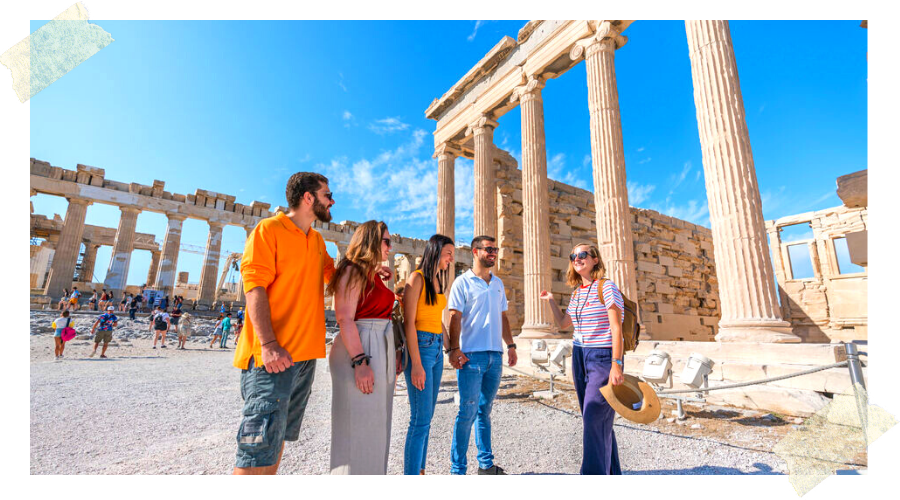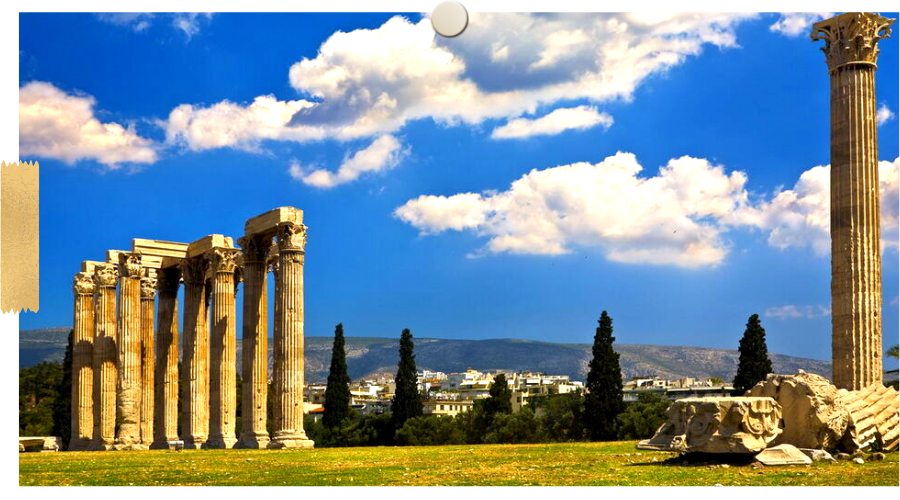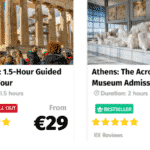The Official Ticketing Site for Acropolis Tickets online 2024 [Guide]
Acropolis of Athens is one of the most famous symbols of Greece.
Acropolis of Athens – GUIDE 2024
The
Acropolis in 2024
-
Wear comfortable shoes: The
Acropolis is a large site with uneven surfaces, so wear comfortable shoes that provide good support and traction. -
Bring water and a hat: The site can be quite hot during the summer months, so make sure to bring plenty of water to keep yourself hydrated and a hat to protect yourself from the sun.
-
Arrive early or late: Try to arrive at the site as early as possible or in the late afternoon to beat.
Quick Links to Tickets for the Acropolis
Quick Links to tickets for the
► Skip-the-line tickets can be purchased online via GetYourGuide Click HERE <- (includes free cancellation)
Or Tiqets Click HERE <- (does not include free cancellation).
Viator Click Here (includes free cancellation)

Get Priority Access to Athens Top Attractions!
► A popular combination is Entry tickets to both the
Or, continue reading this page to explore all ticketing options in preparation for your visit to the

What are the main landmarks of the Acropolis of Athens?
The
-
The Parthenon: This ancient temple is dedicated to the goddess Athena, and it is considered one of the most iconic and recognizable landmarks of ancient Greece. It is famous for its intricate sculptures and its impressive size and scale.
-
The Erechtheion: This temple is dedicated to both Athena and Poseidon, it is known for its distinctive caryatid porch, which is supported by six female figures.
-
The Propylaea: This monumental entrance gate is the main entrance to the
Acropolis and is known for its grand scale and architectural detail. -
The Temple of Athena Nike: This temple is dedicated to the goddess Athena and is located on the southwest corner of the
Acropolis . It is known for its intricate carvings and its unique location on a steep outcropping. -
The Odeon of Herodes Atticus: This ancient theater was built in the 2nd century AD and was used for musical performances and speeches. It is located on the south slope of the
Acropolis . -
The Theater of Dionysus: This ancient theater is located on the south slope of the
Acropolis and was used for performances of plays, poetry, and music. -
The Ancient Sanctuary of Zeus Polieus: It was dedicated to Zeus Polieus, one of the many cults of Zeus in ancient Athens.
These landmarks are considered some of the most important
How long does it take to visit the Acropolis of Athens?
The amount of time it takes to visit the
It’s recommended to allocate at least 2-3 hours to visit the
Additionally, you can visit the nearby
Also, keep in mind that the
What is the best time of day to visit the Acropolis ?
The best time of day to visit the
-
Early morning: Arriving at the
Acropolis early in the morning (before 9:00 am) can be the best time to visit, as the site is less crowded and the lighting is ideal for photography. This can also be the best time to avoid the heat of the day and the crowds. -
Late afternoon: Another good time to visit is late in the afternoon (around 4:00 pm) when the crowds have thinned out, and the lighting is again ideal for photography.
-
Avoid peak hours: The
Acropolis can get very crowded during the peak tourist season, so it’s best to avoid visiting during peak hours (between 9:00 am and 3:00 pm) if you want to avoid the crowds. -
Consider the season: The best time of day to visit the
Acropolis also depends on the season, during summer days the best time is early in the morning or late in the evening, as the sun can be strong and the heat can be intense.
Whichever time you choose, it’s important to remember that the
What is the history behind the Parthenon temple?
The Parthenon is an ancient temple located on the
The Parthenon was built to replace an older temple that was destroyed in the Persian invasions of 480-479 BC. The temple was designed by the architects Ictinus and Callicrates, and the sculptor Phidias was responsible for creating the statue of Athena and the other sculptures that adorned the temple.
The temple was built using marble from the nearby Mount Pentelicus, and it features a complex system of architectural elements, including columns, pediments, and friezes. The temple’s iconic columns are in the Doric order, and its friezes depict scenes from Greek mythology, including the contest between Athena and Poseidon for the patronage of Athens.
The Parthenon was used as a temple for over a thousand years, and during that time, it was also used as a treasury, a church, and a mosque. It was also used as a weapons store by the Venetians, which caused it severe damage during the 17th century.
Today, the Parthenon is considered one of the greatest surviving examples of ancient Greek architecture and is a UNESCO World Heritage Site.
Is There a Dress Code for Visiting the Acropolis ?
There is no official dress code for visiting the
It is recommended that visitors wear comfortable shoes, as the site has uneven surfaces, and to dress appropriately for the weather, as the site can be quite hot during the summer months.
It is also recommended to be dressed modestly, this means that it is better to avoid revealing clothing, especially when visiting religious sites such as the Parthenon temple.
In addition, visitors should avoid climbing on the ruins or making noise or loud music when visiting the site, as the
Overall, the dress code is not strictly enforced, but dressing respectfully when visiting the
Can I take photos on the Acropolis ?
Yes, visitors are allowed to take photos on the
It is recommended to avoid using flash when taking photos, as it can be disruptive to other visitors and can cause damage to the ancient structures. It’s also best to avoid climbing on the ruins to take photos as it is not safe, and it can cause damage to the site.
Additionally, it is important to note that commercial photography or video recording require a permit from the Greek Ministry of Culture and Sports.
Lastly, it’s a great idea to take advantage of the early morning or late afternoon lighting to take the best photos of the
Are there guided tours available for the Acropolis ?
Yes, there are several guided tours available for the
Guided tours can be arranged through a tour agency or directly through the Greek Ministry of Culture and Sports. These tours are typically led by licensed guides who are knowledgeable about the history and culture of the site. Some tours also include audio guides that provide additional information about the site.
There are also self-guided audio tours available, which can be rented at the ticket office, it can provide information about the history of the site and the different structures, and help you to understand the significance of the
You can also consider a private guide, they are licensed professional guides who can provide you with personalized tours and tailor the experience to your interests and needs.
Keep in mind that the
Are there any restrictions on access to certain areas of the Acropolis ?
There are some restrictions on access to certain areas of the
For example, access to the Parthenon is limited, due to ongoing conservation work, visitors can only view the temple from the outside, and it’s not allowed to enter inside the temple. Additionally, access to the Propylaea, the monumental entrance gate, is also limited as it is under restoration.
There are also areas that are closed to the public for safety reasons, such as the scaffoldings and the areas that are under construction.
It’s important to note that certain areas may be closed or have restricted access during inclement weather, such as high winds or heavy rain, to ensure the safety of visitors.
The
Are there any special events or festivals held at the Acropolis ?
There are several special events and festivals held at the
-
Athens Festival: This annual festival takes place during the months of June and July and features a variety of cultural events, including theater, music, and dance performances. Some of the events take place at the Odeon of Herodes Atticus, which is located on the south slope of the
Acropolis . -
The Lighting of the
Acropolis : This annual event takes place in the evening and features a spectacular light show that illuminates theAcropolis and its monuments. It usually takes place in April or May. -
Athens Open Air Film Festival: This annual film festival takes place during the summer months and features a variety of films shown on a big screen at the
Acropolis . -
Athens Half Marathon: This annual event takes place in November and starts at the foot of the
Acropolis and finishes at the Panathinaikon Stadium. -
Epiphany Day Celebration: This annual event takes place on January 6th, it’s a Christian Orthodox festival, and it includes a mass in the church of Agios Dionysios Areopagitis, located at the base of the
Acropolis .
It’s worth checking the official website of the Greek Ministry of Culture and Sports to confirm the dates and programming of these events.
Please note that due to the COVID-19 pandemic, the schedule of the events may change, and the events may be cancelled, modified or held online.
Are there any nearby museums or sites that complement a visit to the Acropolis ?
Yes, there are several nearby museums and sites that complement a visit to the
-
Acropolis Museum: This museum is located at the base of the
Acropolis and houses many artifacts from theAcropolis , including sculptures, pottery, and other artifacts. It provides a great introduction to the history and culture of ancient Greece. -
Ancient Agora: This is an ancient marketplace and public gathering place located just below the
Acropolis . It was the center of political, commercial and social life in ancient Athens. It’s home to several important landmarks including the Stoa of Attalus and the Temple of Hephaestus. -
Roman Agora: This is an ancient marketplace and public gathering place located in the northwest of the ancient city of Athens, it’s a bit further from the
Acropolis but it’s still worth visiting. It’s home to several important landmarks such as the Tower of the Winds and the Gate of Athena Archegetis. -
Theater of Dionysus: This ancient theater is located on the south slope of the
Acropolis and was used for performances of plays, poetry, and music. -
Areopagus Hill: This hill is located just northwest of the
Acropolis , it’s a rocky outcropping that offers great views of theAcropolis and the surrounding city. It’s also the site of the ancient court of the Areopagus, where the apostle Paul preached. -
Philopappos Hill: It’s a small hill located southeast of the
Acropolis , it offers a panoramic view of the city and the sea.
Are there any restaurants or cafes in the Acropolis of Athens ?
There are several restaurants and cafes located near the
There are some small snack bars and souvenir shops located near the ticket office, but they don’t have a wide variety of options, so you may want to consider bringing snacks and water with you when you visit the
However, there are several restaurants and cafes located in the surrounding area that offer a variety of options for food and drink, both traditional Greek and international cuisine. Most of them are located in the Plaka neighborhood, which is a short walk from the
It’s also a good idea to check out the Monastiraki Flea Market, which is located just a few minutes’ walk from the
Additionally, there are a few restaurants and cafes located in the nearby museums such as the
Is the Acropolis of Athens accessible for people with disabilities?
The
There is a ramp that leads to the ticket office and the site is equipped with some wheelchair accessible toilets, however, the site is an ancient one, and it has uneven surfaces and steep inclines, which can make it challenging for people with mobility impairments.
Additionally, the access to some of the buildings such as the Parthenon, the Propylaea and the Erechtheion is not accessible for wheelchairs and is only accessible by stairs.
The
It’s recommended that visitors with mobility impairments contact the Greek Ministry of Culture and Sports in advance, to inquire about the accessibility of the site, and to arrange for any necessary assistance.
It’s also important to note that some of the guided tours are not accessible for wheelchairs, but they can provide alternative routes or access to the information in other ways.
Are there any audio guides or mobile apps available for the Acropolis of Athens?
Yes, there are audio guides and mobile apps available for the
Audio guides are available for rent at the ticket office, they are available in several languages and provide information about the history of the site and the different structures.
Additionally, there are several mobile apps available that provide information about the
It’s important to note that the use of audio guides and mobile apps are subject to change depending on the COVID-19 pandemic and the regulations in place.
It’s a good idea to check the official website of the Greek Ministry of Culture and Sports for the most up-to-date information about the availability of audio guides and mobile apps for the
Are there any parking facilities near the Acropolis of Athens?
There are several parking facilities located near the
There are several paid parking lots located near the
You can also find street parking in the surrounding neighborhoods, but it can be limited and it can be difficult to find a spot during peak tourist season. Additionally, street parking in Athens can be challenging as the parking spots are not always well marked, and it’s important to pay attention to the parking signs and regulations.
It’s also worth considering using public transportation to get to the
In summary, while there are parking options available near the
Acropolis of Athens and temples are international icons of ancient culture and energy.
Every day thousands of people climb its breathtaking terraces, admire its sculptures and buildings, and enjoy stunning vistas across the Egean Sea. So Join us on this fascinating tour through the magnificent
Greek Antiquity’s finest architectural and artistic complex has been handed to the world.
So, following its triumph against the Persians and the institution of democracy, Athens came to prominence among the ancient world’s city-states in the second half of the fifth century bc.
See also:
Pay 1/3 the price to see all the sights of Athens.
CLICK HERE 👇
Tickets for the Acropolis, Athens – Updated Guide
Athens: The Acropolis Entry Ticket and Welcome Walk CLICK HERE <- www.getyourguide.com
An remarkable collection of painters carried out the lofty goals of Athenian leader Pericles in the age that followed, when intellect and art thrived. Under the brilliant leadership of the sculptor Pheidias, transforming the rocky slope into a one-of-a-kind temple of philosophy and the arts.
Where to Buy Tickets for the Acropolis ” The 16 Best Q&As of 2022 – CLICK HERE <-
Tours of the Acropolis with skip-the-line tickets for
small groups of visitors. GetYourGuide CLICK HERE <-
The Athens Mythology Highlights Tour
 Before you buy tickets, read the guide for 2024. Click Here
Before you buy tickets, read the guide for 2024. Click Here




